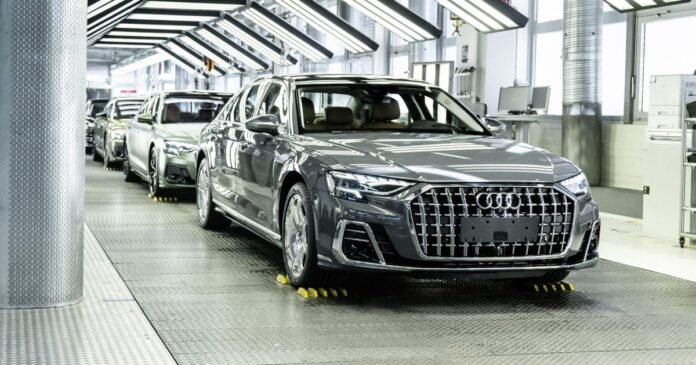Production of the current Audi A8 is due to finish by the end of 2026, and it’s not clear what will succeed it, if anything.
Under the original plan the A8 was due to be replaced by a pair of vehicles in 2027: a SUV nicknamed Landjet and a sedan dubbed Landyacht. Both were to be based on the sports variant of the Volkswagen Group’s new electric-only Scaleable Systems Platform (SSP).
Engineering work on SSP Sport was being led by Porsche, which was planning to use the platform as the basis of a new three-row electric SUV codenamed ‘K1’.
CarExpert can save you thousands on a new car. Click here to get a great deal.
With EV sales growth not meeting expectations, especially at the top of the market, Porsche cancelled K1 in late September, and will instead develop a different three-row SUV with petrol and plug-in hybrid drivetrains. As a result, the SSP Sport architecture won’t be production ready until some time in the 2030s.
Without SSP Sport available, Audi has some tough decisions about the next A8. It could be based on the Platform Premium Combustion (PPC), which underpins the latest petrol and plug-in hybrid A6, or it could use a lengthened version of Platform Premium Electric (PPE) that serves as the basis of the Audi A6 E-tron and Q6 E-tron, as well as the Porsche Macan EV and the upcoming Cayenne EV.
The most obvious solution, facelifting and updating the current A8, has already been ruled out. An Audi spokesperson told Automotive News, a refreshed fourth-generation A8 is “not an option” due to the cost of meeting the latest regulations.

After pressure from employee representatives, Audi is expected to decide on a path for the new A8 by the end of the year. Whatever the Audi board decides, the car that replaces the fourth-generation A8 will take a time to develop, leaving a gap at the top of the Audi’s sedan range for a few years, at least.
Local sales of the fourth-generation A8 ended earlier this year when Audi Australia withdrew the S8 from our market.
In the meantime, Audi’s large SUVs will take on the role of being the brand’s flagship models, with a new generation of the Q7 due to be launched by the end of 2025.

The original A8 was unveiled in 1994 featuring the bespoke weight-saving Aluminium Space Frame. The A8 hid its revolutionary engineering behind a handsome, if overly derivative body that looked too much like a stretched A6.
While the original A8 and its successors never usurped the Mercedes-Benz S-Class and BMW 7 Series on the sales charts, it did blaze a path for the widespread use of aluminium and other lightweight materials to improve fuel consumption.
It’s possible to argue, the 13th-generation Ford F-150, launched in 2015, wouldn’t have made the switch to an all-aluminium body were it not for the A8 two decades earlier.
MORE: Explore the Hyundai i30 showroom
